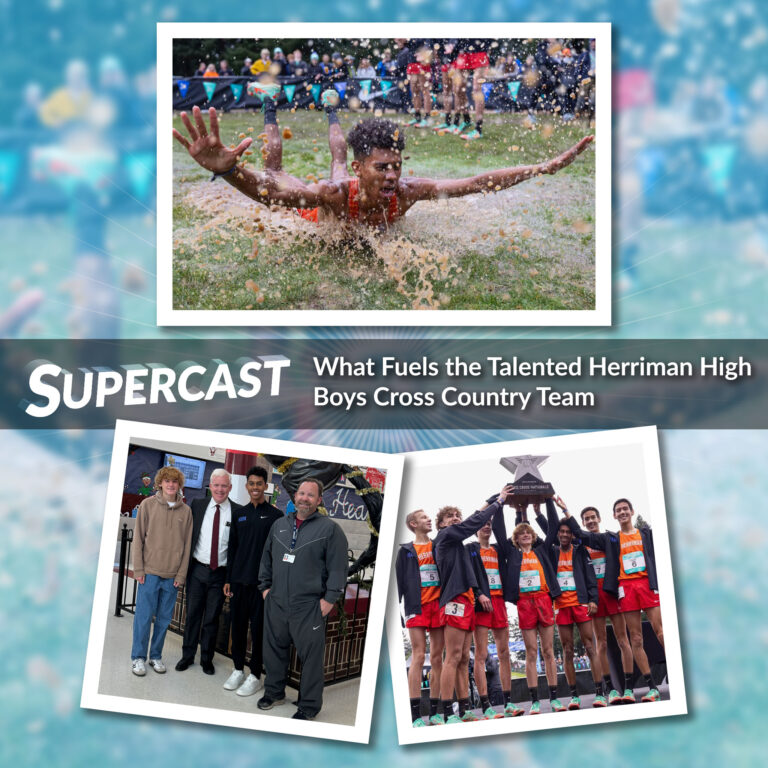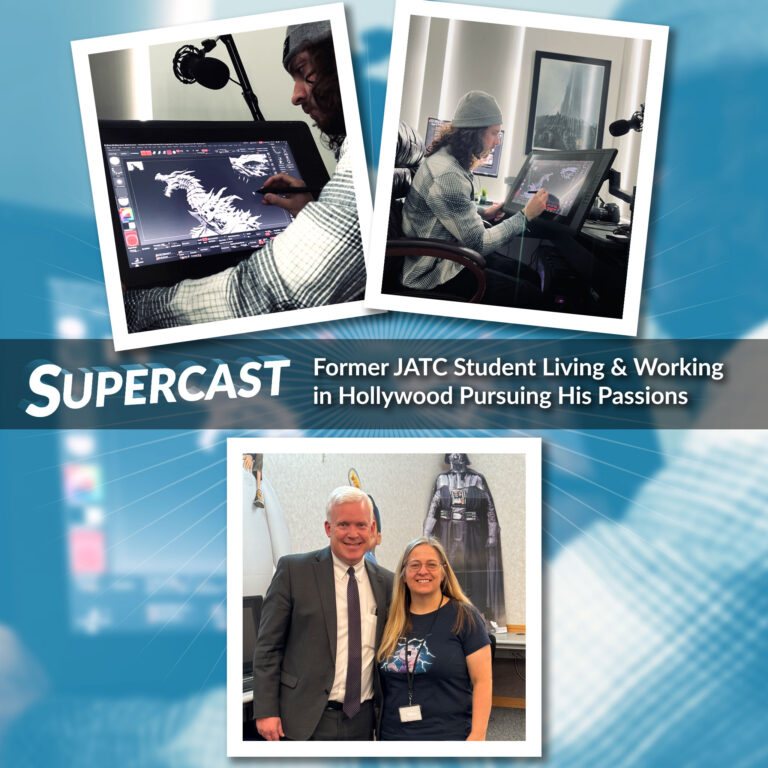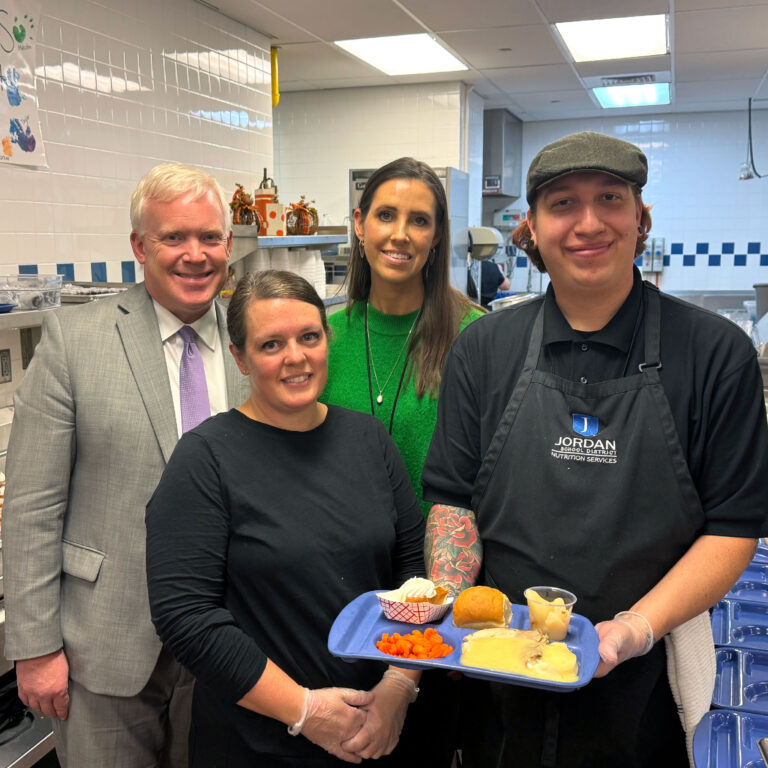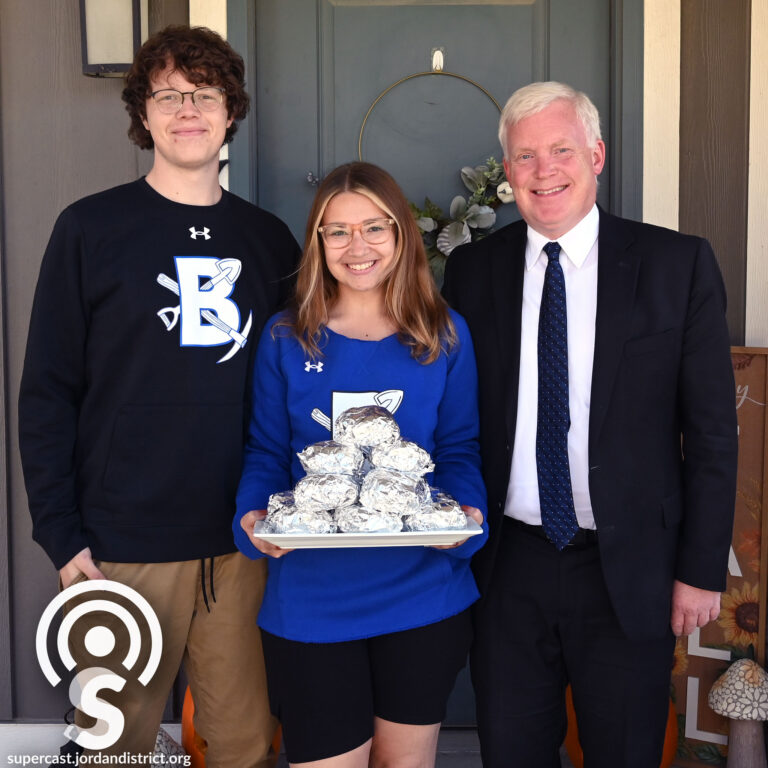They rally for some really good causes and have a lot of fun in the process. On this episode of the Supercast, we take you to Bingham High School where students are taking the stage as part of the Mr. True Blue talent show.
Find out what the tradition of Bingham’s “True Blue” charity drive, giving back over the holiday season is all about, and who it is helping this year.
Audio Transcription
[Music]Anthony Godfrey:
Hello and welcome to the Supercast. I'm your host, Superintendent Anthony Godfrey. Each year, all of our high schools rally for some really great causes and have a lot of fun in the process.
On this episode of the Supercast, we bring you to Bingham High School, where students are taking the stage as part of the Mr. True Blue talent show. Find out what the tradition of Bingham's True Blue charity drive is all about and who they are helping this year.
We are here with Brenna Miller at Bingham High School in the last moments before the beginning of Mr. True Blue. Will you introduce yourself, talk about your role with this, and help everyone understand what Mr. True Blue is all about?
Brenna Miller:
Yeah, of course. My name is Brenna Miller. I'm the senior class president this year at Bingham. Mr. True Blue is the biggest event of our entire True Blue season. It's where a bunch of senior boys come together, they prepare, and then they perform in a beauty pageant. It's one of the most favorite events of True Blue. It's really widely attended. It's really fun for everyone to get together and kind of just laugh. Everyone gets to dress up when they come, which is a fan favorite. Everyone wears their prom dresses and nice suit and ties. We all come and watch the senior boys perform.
Anthony Godfrey:
Now, there are a number of categories I assume in which they will be performing. Can you tell me about those categories and how all the scoring works?
Brenna Miller:
Yes, of course. We bring back judges, whether that be administration, teachers, and student government from previous years. It's no one that's still in high school. They come back and they'll watch the boys perform in an interview portion, which is based on questions that they've answered in a packet earlier on. They had to apply, they had to raise money in order to get into the package.
Anthony Godfrey:
So there's already been a cut made?
Brenna Miller:
Yes, there has been.
Anthony Godfrey:
This is the elite tonight?
Brenna Miller:
Of course, yes.
Anthony Godfrey:
Okay.
Brenna Miller:
So they'll interview. The judges will ask them a couple questions. They'll get to answer, talk about maybe their platform issue that they've discussed in their interview packet. And then after that, they're going to do a runway portion where they're going to show off their best evening wear, whether that be suit and tie or whatever they have in mind. But Mr. Dave, our student government advisor, and also he's over theater, built us a really nice runway this year with lights and everything. So we're really excited to show that off.
Anthony Godfrey:
Wow, that's awesome.
Brenna Miller:
And then after that, they do a Christmas wear portion. So they'll do the runway one more time, but in their best Christmas outfit, 'tis the season. And then they'll end with a talent portion. So talents can range from whatever you want. We've had in past years, we had a boy deliver a pizza. He worked at Domino's and he felt like that was his big talent. We've had boys sing songs they wrote, original songs. And we've had boys make guacamole. Whatever they feel like they're talented at, they can perform.
Anthony Godfrey:
Wow. I'm glad that you welcome all talents.
Brenna Miller:
Yes, anything they want to do, the funnier, the better.
Anthony Godfrey:
That's fantastic. Now, this is a fundraiser as part of the overall charitable efforts that are the True Blue efforts of this month.
Brenna Miller:
Yeah.
Anthony Godfrey:
Tell us about how this fits into all of that.
Brenna Miller:
Of course. So this year Bingham is happy to be supporting a really local organization. It's called Nixon Strong and it's a family that lives just here in South Jordan. They had a son that was really involved in athletics, Bingham athletics, especially growing up with basketball, baseball, football. He ended up being diagnosed with cancer and unfortunately passed away a couple of years ago. So his family decided that they wanted to start a program, start an organization that could help give money to other families who are in similar situations, their children were suffering from cancer or other diseases.
They really wanted to be able to like help families go on trips, sort of like Make-A-Wish. But they also pay for a lot of other things like funeral expenses or sometimes medical things that like insurance wouldn't cover. Like they bought a hot tub for a family and they bought a service dog for a girl who ended up going blind and like kind of things like that. So we're really excited to be partnering with them this year.
We've been doing events all month to try and raise money and every dollar that we get goes straight to them. So Mr. True Blue is a good night. We get a lot of people coming in. So they pay five dollars.
Anthony Godfrey:
And you're charging admission five dollars to come in. Okay.
Brenna Miller:
And there's VIP seats where people pay seven dollars. You get to sit right up in the front. You get a little snack bag. You get to be up close with the judges, up close with the candidates. So people go pretty feral for those.
Anthony Godfrey:
Very nice. I like the pricing structure that gets the most charitable donations that you can possibly muster.
Brenna Miller:
Yes.
Anthony Godfrey:
There are a lot of people involved. We were out in the hall just a minute ago and there's a lot of scurrying around doing some last minute preparation. Tell me about the efforts leading up to this. I talked with you about this several weeks ago. Things were well underway already.
Brenna Miller:
Yes. I mean we start planning all of True Blue starting at Gov Camp which is in June.
Anthony Godfrey:
Wow. Usually by around August we've already picked an organization and we're already penciling in dates for. We have our Christmas dance. All the money from that goes to Make-A-Wish every year. So we've already communicated with the organizations we'll be partnering with. So we start planning really early.
Mr. True Blue, we had already had the date scheduled and everything in June. And I mean we had to write all the information packets, all the application packets and get everyone involved. So it's been a pretty long time coming but we're super excited for it to all come together tonight hopefully.
Anthony Godfrey:
Well it's a big night. I'm sure it's going to go great and I can't wait to see it. I've never seen it. I've heard a lot about it. So I'm really looking forward to being part of it tonight. And thank you for everything that you're doing to make this charitable effort so successful.
Brenna Miller:
Yes of course. We're so glad you guys are here.
Anthony Godfrey:
And it's a great time on top of that.
Brenna Miller:
Yes. It's a great day to be a Miner always.
Anthony Godfrey:
Okay. Fantastic. Thanks Brenna.
Brenna Miller:
Yes of course. I'll let you get back to everything.
Brenna Miller:
Thanks.
Anthony Godfrey:
And now Annie Millerberg is going to tell us a little bit about being senior class VP and what all this means to you.
Annie Millerberg:
You know it's a lot of like work and time that people don't realize you put in. But I mean it's completely worth it. I was recently writing some scholarship essays and I wrote that it's like it's worth the hard work because it's worth seeing the work. And I think that's so essential when it comes to student government and all of the people that put in work behind the scenes. It really- like all the money that we're contributing to True Blue and to the Nixon Strong Foundation, it's really just going to such a great cause. I think that the hard work is completely worth it even though it is a lot and it is stressful it's completely worth it when it all comes and boils down to it.
Anthony Godfrey:
Tell me what you're looking forward to most this evening.
Annie Millerberg:
You know I'm just really excited to see these boys' talents. We got a unicycler. We have some balloon animals. We have someone who's writing, who's singing a song that they wrote.
Anthony Godfrey:
Wow.
Annie Millerberg:
It's a wide variety of talents and I'm really excited and I think our audience will be very entertained.
Anthony Godfrey:
That's awesome. Do people generally know who has made the cut and who will be competing tonight?
Annie Millerberg:
Um, generally.
Anthony Godfrey:
Or is that kind of a surprise tonight when they see everybody up on the stage?
Annie Millerberg:
It honestly depends on who you're asking and who you know. For the most part, it's just kind of a surprise. People who are friends with our contestants most of the time know what's going on. They've heard what's happening behind the scenes. But mostly it's a surprise when they come and show up and they're like, "Wow, I didn't know that my friend was in this." And it just is a great surprise for everybody.
Anthony Godfrey:
Well, I hope there's a great turnout tonight. I have no doubt it's going to be a blast. The stage already looks really cool. I can kind of feel the pressure on behalf of these boys.
Annie Millerberg:
Oh, I know. Look at how many chairs we have.
Anthony Godfrey:
We see the Christmas trees on either side. We got a lot of chairs up there. So the competition is going to be stiff.
Annie Millerberg:
This is actually our, I think, highest amount of boys participating that we've ever had. We have doubled our amount from last year.
Anthony Godfrey:
Wow. That's great.
Annie Millerberg:
So last year we, well, almost doubled. Last year we had eight and this year we have fifteen, which is crazy. But it should be very entertaining to watch.
Anthony Godfrey:
The stakes are high.
Annie Millerberg:
Stakes are very high, higher than ever.
Anthony Godfrey:
We're looking forward to it. Thank you very much for all your hard work.
Annie Millerberg:
Thank you so much. We appreciate you.
Anthony Godfrey:
Stay with us. When we come back hear from some of our Mr. True Blue talent show contestants.
Break:
Hello, I'm Sandy Riesgraf, Director of Communications for Jordan School District, and we want to invite you to connect with us. So many exciting things are happening in your child's school, your neighbor's school, in every school here, every day. Don't miss out on following the fun or simply staying informed when there's important information we need to share. Join us at jordandistrict.org, or follow us on Facebook, Twitter, and Instagram @jordandistrict. We can't wait to connect.
Anthony Godfrey:
We're now talking with two of the contestants for Mr. True Blue. Introduce yourself and tell us how you're feeling just a few minutes before the competition.
Tyler Atkinson:
Hi, my name is Tyler Atkinson. I'm feeling nervous but excited for sure.
Dillan Orr:
I'm Dillan Orr:
I'm feeling very excited. I've been looking forward to this since last year.
Anthony Godfrey:
So apparently you came last year, you saw other boys compete. And did you think that's going to be me? I'm going to be up there.
Tyler Atkinson:
Absolutely. One of my best friends won last year and ever since I wanted to follow in his footsteps.
Dillan Orr:
Same here, same friend.
Anthony Godfrey:
Okay. Right. So if the same friend inspired you, are you feeling competitive against each other? Are you just supporting each other to be at your best and let's see what happens?
Tyler Atkinson:
I am fine with anyone winning. It's a bunch of my closest friends competing up there. And honestly, any one of them could win and I'd be happy. As long as we raise money and did what the goal of this was to do.
Anthony Godfrey:
Yeah.
Dillan Orr:
I agree. I feel like if there were fewer contestants, it might be more competitive. But with 15 of us, it really is just kind of a dice roll. We don't know what everyone's going to bring to the table. And it's exciting to see what will turn out.
Anthony Godfrey:
Well, I can't wait to see what happens. It sounds like there's going to be a wide variety of talents on display. Is there anything last year that particularly inspired you to participate? Is there one moment where you thought, wow, that's really fun? I know what I can do now.
Tyler Atkinson:
The winner of last year, his best friend came in second place and he sang a really like - everyone else's talent was really exciting, very energetic. And his was, he just played the ukulele and sang a love song. And it just like hit that I was like, you can make people feel something even in like a beauty pageant. So I was like, I kind of want to try something like that.
Anthony Godfrey:
Okay. Excellent.
Dillan Orr:
I'm going more after the winner's way of getting the win in going with the more exciting type song.
Anthony Godfrey:
You're going for energy.
Dillan Orr:
Energy, yeah. And a bit of love and romance in there too.
Anthony Godfrey:
I'm looking forward to it. There'll be a lot of swooning out there in the audience.
Tyler Atkinson:
That's the hope.
Anthony Godfrey:
Tell me what does it mean to be part of True Blue overall and raising money for an important cause?
Tyler Atkinson:
Overall, it's just incredible. Just being able to help with your entire school and knowing that with everyone else you can make that big of a difference for that many kids is just so amazing.
Dillan Orr:
And like Brenna said earlier, Nixon Strong is a local foundation. And so it's cool to know that there was somebody around here because sometimes foundations feel very broad. Like it's like support children, but it's like, okay, there's children everywhere. But like it was a family here in South Jordan went to Bingham. And so it's really cool being able to continue to build that legacy and be able to support people in our community instead of just out there.
Anthony Godfrey:
So you feel a deeper connection with the with the charity because it's it's local.
Dillan Orr:
Absolutely.
Anthony Godfrey:
Tell me about your preparation. What are some of the things you've done to be your best tonight?
Dillan Orr:
I have been. This song came out in a movie like during the summer. And ever since then, I was like, I think this is the song I want to do. So I sing it probably at least once a week to make sure I have it down. I had it memorized and everything.
Anthony Godfrey:
And so it really has been on your brain since last year.
Dillan Orr:
Absolutely. Oh, absolutely. I've been thinking about what I'm going to do for the entire year. I've had a lot of different options. But as soon as the song came out, I was like, this is go time. This is what I'm doing.
Anthony Godfrey:
Okay, great. How about for you? What does your preparation look like?
Tyler Atkinson:
I knew what song I wanted to do. It's also from a movie that I love. And so I've just I've known it forever pretty much. And then clothing changes. I've got a bunch of costumes for the runway. I've prepped them all. Made sure they all match. Tested them with my sisters and been like, “Is it good? Does it match?” So that was really fun to just be able to try on a bunch of different outfits and see what would work best.
Anthony Godfrey:
I'm guessing sisters have come in pretty handy in these circumstances.
Tyler Atkinson:
Oh, yeah.
Anthony Godfrey:
Any words of advice for those who might hear about this or see it tonight and think, hey, that can be me next year?
Tyler Atkinson:
Think less about yourself and think more about the cause and what it can do and how people in the audience will feel about it. And just don't just do it to be like, “oh, I'm gonna I'm gonna sing and I'm gonna win” or I'm gonna do whatever my talent is. Do it for the charity and do it for the people to watch.
Anthony Godfrey:
Well, I can't wait. I think it's gonna be a blast. And I like your chances, both of you. I think you're gonna have a great night, whatever the result is, because you've prepared and you're gonna have a great time.
Dillan Orr:
Thank you.
Anthony Godfrey:
We're here with the senior class advisor. Introduce yourself and tell us a little bit about what's going on here.
Dave Martin:
So my name is Dave Martin. I'm a second-year teacher here at Bingham High School and I am the theater teacher, but I also have the opportunity to work with the student government as a senior class advisor. True Blue is a school-wide fundraiser that we do each year to benefit those in need at the Christmas season. And we institute, enlist the help of all of the students and faculty and the community to make a positive change in somebody's life who could really use it this time of year.
Anthony Godfrey:
And we hear a lot of activity around here. Treats being thrown, seats being reserved for the VIP section. Mr. True Blue is a big event. Now you're fairly new to Bingham.
Dave Martin:
Correct.
Anthony Godfrey:
Tell me about how this feels coming into an old tradition.
Dave Martin:
I got my MPA from BYU with the emphasis in nonprofit work. So this is right up my alley.
When I found out working here at Bingham that this is something that they did, I just jumped all over it. It was such a great opportunity to see these kids really come alive, to go out every night to do what they call squad jobs, to ask members of the community if they can do the odds and end jobs to raise money. So far we've really brought in quite a lot of money and so I'm so proud of the kids, proud of the school. Bingham has a rich heritage and I think this is a great way to keep us in a really great tradition.
Anthony Godfrey:
I think we need to talk with you more in a future episode about some of your own projects. I know you do a lot of things on your own just outside of school to help raise money and support those in need. Tell me about the students at Bingham.
Dave Martin:
The students at Bingham are really just amazing kids and we are fortunate to work with student government kids who put in just so many hours putting all of this together but then also reaching out to their fellow students to get them involved as well. We've got a lot of club support which has been awesome.
We decorated all the hallways here at Bingham for our Deck the Halls tradition. And it's just really great to just see these kids who you already know they're amazing students anyways. Whether they're in the classes that we have or the activities or the shows or any of the different things that we've got going on but then to see them pivot to really selfless service it just really shows us just another level, a deeper level of how amazing these kids are.
Anthony Godfrey:
Well, thanks again for all of your support of these efforts and the expertise that you bring to it. And it's going to be an exciting night, I can't wait.
Dave Martin:
You too, thank you.
Anthony Godfrey:
Thanks for joining us on another episode of the Supercast. Remember education is the most important thing you'll do today. We'll see you out there.





